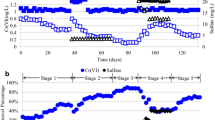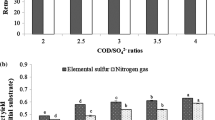Abstract
The strictly anaerobic serum bottles were applied to investigate methane oxidation coupled to chlorate (ClO3−) reduction (MO-CR) without exogenous oxygen. 0.35 mM ClO3− was consumed within 20 days at the reduction rate of 17.50 μM/d, over three times than that of ClO4−. Chlorite (ClO2−) was not detected throughout the experiment and the mass recovery of Cl− was over 89%. Isotope tracing results showed most of 13CH4 was oxided to CO2, and the electrons recovery reached to 77.6%. Small amounts of 13CH4 was consumed for DOC production probably through aerobic methane oxidation process, with oxygen generated from disproportionation reaction. In pMMO (key enzyme in aerobic oxidation of methane) inhibition tests, ClO3− reduction rate was slowed to 7. 0 μmol/d by 2 mM C2H2, real-time quantitative PCR also showed the transcript abundance of pMMO and Cld were significantly dropped at the later period of experiment, indicating that the O2 disproportionated from ClO2− was utilized to active CH4. NC10 bacteria Candidatus Methylomirabilis, related closely to oxygenic denitrifiers M. oxyfera, was detected in the system, and got enriched along with chlorate reduction. Several pieces of evidence supported that NC10 bacteria promoted CH4 oxidation coupled to ClO3− reduction, these oxygenic denitrifiers may perform ClO2− disproportionation to produce O2, and then oxidized methane intracellularly.






Similar content being viewed by others
References
Alrashed W, Lee J, Park J, Rittmann B, Tang Y, Neufeld J, Lee H-S (2018) Hypoxic methane oxidation coupled to denitrification in a membrane biofilm. Chem Eng J 348:745–753
Atashgahi S, Hornung B, van der Waals MJ, da Rocha UN, Hugenholtz F, Nijsse B, Molenaar D, van Spanning R, Stams AJM, Gerritse J, Smidt H (2018) A benzene-degrading nitrate-reducing microbial consortium displays aerobic and anaerobic benzene degradation pathways. Sci Rep 8:12
Bardiya N, Bae JH (2011) Dissimilatory perchlorate reduction: a review. Microbiol Res 166:237–254
Campbell IT, Brand U (1998) Henry's lawHenry's law. Geochemistry. Encyclopedia of Earth Science. Springer, Dordrecht, pp 315–315. https://doi.org/10.1007/1-4020-4496-8_155
Caporaso JG, Bittinger K, Bushman FD, DeSantis TZ, Andersen GL, Knight R (2010) PyNAST: a flexible tool for aligning sequences to a template alignment. Bioinformatics 26:266–267
Chen R, Luo Y-H, Chen J-X, Zhang Y, Wen L-L, Shi L-D, Tang Y, Rittmann BE, Zheng P, Zhao H-P (2016) Evolution of the microbial community of the biofilm in a methane-based membrane biofilm reactor reducing multiple electron acceptors. Environ Sci Pollut Res 23:9540–9548
Coates JD, Achenbach LA (2004) Microbial perchlorate reduction: rocket-fuelled metabolism. Nat Rev Microbiol 2:569–580
Dudley M, Salamone A, Nerenberg R (2008) Kinetics of a chlorate-accumulating, perchlorate-reducing bacterium. Water Res 42:2403–2410
Ettwig KF, Butler MK, Le Paslier D, Pelletier E, Mangenot S, Kuypers MMM, Schreiber F, Dutilh BE, Zedelius J, de Beer D, Gloerich J, Wessels H, van Alen T, Luesken F, Wu ML, van de Pas-Schoonen KT, den Camp H, Janssen-Megens EM, Francoijs KJ, Stunnenberg H, Weissenbach J, Jetten MSM, Strous M (2010) Nitrite-driven anaerobic methane oxidation by oxygenic bacteria. Nature 464:543
Ettwig KF, Shima S, van de Pas-Schoonen KT, Kahnt J, Medema MH, Op den Camp HJM, Jetten MSM, Strous M (2008) Denitrifying bacteria anaerobically oxidize methane in the absence of Archaea. Environ Microbiol 10:3164–3173
Ettwig KF, Speth DR, Reimann J, Wu ML, Jetten MSM, Keltjens JT (2012) Bacterial oxygen production in the dark. Biochim Biophys Acta-Bioenerg 1817:S155–S155
Haroon MF, Hu SH, Shi Y, Imelfort M, Keller J, Hugenholtz P, Yuan ZG, Tyson GW (2013) Anaerobic oxidation of methane coupled to nitrate reduction in a novel archaeal lineage. Nature 500:567
Hatamoto M, Kimura M, Sato T, Koizumi M, Takahashi M, Kawakami S, Araki N, Yamaguchi T (2014) Enrichment of denitrifying methane-oxidizing microorganisms using up-flow continuous reactors and batch cultures. PLoS One 9:12
Hatamoto M, Sato T, Nemoto S, Yamaguchi T (2017) Cultivation of denitrifying anaerobic methane-oxidizing microorganisms in a continuous-flow sponge bioreactor. Appl Microbiol Biotechnol 101:5881–5888
Hinrichs KU, Hayes JM, Sylva SP, Brewer PG, DeLong EF (1999) Methane-consuming archaebacteria in marine sediments. Nature 398:802–805
Kits K, Klotz M, Stein L (2015) Methane oxidation coupled to nitrate reduction under hypoxia by the Gammaproteobacterium methylomonas denitrificans, sp. nov. type strain FJG1. Environ Microbiol 17:3219–3232
Knittel K, Boetius A (2009) Anaerobic oxidation of methane: progress with an unknown process. Annu Rev Microbiol 63:311–334
Kool DM, Zhu BL, Rijpstra WIC, Jetten MSM, Ettwig KF, Damste JSS (2012) Rare branched fatty acids characterize the lipid composition of the intra-aerobic methane oxidizer "Candidatus Methylomirabilis oxyfera". Appl Environ Microbiol 78:8650–8656
Lai C-Y, Lv P-L, Dong Q-Y, Yeo SL, Rittmann BE, Zhao H-P (2018a) Bromate and nitrate bioreduction coupled with poly-β-hydroxybutyrate production in a methane-based membrane biofilm reactor. Environ Sci Technol 52:7024–7031
Lai CY, Dong QY, Rittmann BE, Zhao HP (2018b) Bioreduction of antimonate by anaerobic methane oxidation in a membrane biofilm batch reactor. Environ Sci Technol 52:8693–8700
Lai C-Y, Dong Q-Y, Chen J-X, Zhu Q-S, Yang X, Chen W-D, Zhao H-P, Zhu L (2018c) Role of extracellular polymeric substances in a methane based membrane biofilm reactor reducing vanadate. Environ Sci Technol 52:10680–10688
Lai CY, Wen LL, Shi LD, Zhao KK, Wang YQ, Yang X, Rittmann BE, Zhou C, Tang Y, Zheng P, Zhao HP (2016a) Selenate and nitrate bioreductions using methane as the electron donor in a membrane biofilm reactor. Environ Sci Technol 50:10179–10186
Lai CY, Zhong L, Zhang Y, Chen JX, Wen LL, Shi LD, Sun YP, Ma F, Rittmann BE, Zhou C, Tang YN, Zheng P, Zhao HP (2016b) Bioreduction of chromate in a methane-based membrane biofilm reactor. Environ Sci Technol 50:5832–5839
Lawton TJ, Rosenzweig AC (2016) Methane-oxidizing enzymes: an upstream problem in biological gas-to-liquids conversion. J Am Chem Soc 138:9327–9340
Lindqvist MH, Johansson N, Nilsson T, Rova M (2012) Expression of chlorite dismutase and chlorate reductase in the presence of oxygen and/or chlorate as the terminal electron acceptor in ideonella dechloratans. Appl Environ Microbiol 78:4380–4385
Lu Y-Z, Fu L, Ding J, Ding Z-W, Li N, Zeng RJ (2016) Cr(VI) reduction coupled with anaerobic oxidation of methane in a laboratory reactor. Water Res 102:445–452
Luo YH, Chen R, Wen LL, Meng F, Zhang Y, Lai CY, Rittmann BE, Zhao HP, Zheng P (2015) Complete perchlorate reduction using methane as the sole electron donor and carbon source. Environ Sci Technol 49:2341–2349
Lv PL, Shi L-D, Dong Q-Y, Rittmann B, Zhao H-P (2020) How nitrate affects perchlorate reduction in a methane-based biofilm batch reactor. Water Res 171:115397
Lv PL, Shi LD, Wang Z, Rittmann B, Zhao HP (2019) Methane oxidation coupled to perchlorate reduction in a membrane biofilm batch reactor. Sci Total Environ 667:9–15
Maixner F, Wagner M, Lucker S, Pelletier E, Schmitz-Esser S, Hace K, Spieck E, Konrat R, Le Paslier D, Daims H (2008) Environmental genomics reveals a functional chlorite dismutase in the nitrite-oxidizing bacterium 'Candidatus Nitrospira defluvii'. Environ Microbiol 10:3043–3056
Mlynek G, Sjoblom B, Kostan J, Fureder S, Maixner F, Gysel K, Furtmuller PG, Obinger C, Wagner M, Daims H, Djinovic-Carugo K (2011) Unexpected diversity of chlorite dismutases: a catalytically efficient dimeric enzyme from nitrobacter winogradsky. J Bacteriol 193:2408–2417
Ontiveros-Valencia A, Tang Y, Zhao H-P, Friese D, Overstreet R, Smith J, Evans P, Rittmann BE, Krajmalnik-Brown R (2014) Pyrosequencing analysis yields comprehensive assessment of microbial communities in pilot-scale two-stage membrane biofilm reactors. Environ Sci Technol 48:7511–7518
Padilla CC, Bristow LA, Sarode N, Garcia-Robledo E, Ramirez EG, Benson CR, Bourbonnais A, Altabet MA, Girguis PR, Thamdrup B, Stewart FJ (2016) NC10 bacteria in marine oxygen minimum zones. ISME J 10:2067–2071
Raghoebarsing A, Pol A, Pas-Schoonen K, Smolders A, Ettwig K, Rijpstra I, Schouten S, Sinninghe-Damste J, Op den Camp H, Jetten M, Strous M (2006) A microbial consortium couples anaerobic methane oxidation to denitrification. Nature 440:918–921
Shen LD, Wu HS, Gao ZQ, Li J, Liu X (2016) Presence of diverse Candidatus Methylomirabilis oxyfera-like bacteria of NC10 phylum in agricultural soils. J Appl Microbiol 120:1552–1560
Shi L-D, Wang M, Li Z-Y, Lai C-Y, Zhao H-P (2019) Dissolved oxygen has no inhibition on methane oxidation coupled to selenate reduction in a membrane biofilm reactor. Chemosphere 234:855–863
Shi LD, Lv PL, Niu ZF, Lai CY, Zhao HP (2020a) Why does sulfate inhibit selenate reduction: Molybdenum deprivation from Mo-dependent selenate reductase. Water Res 178:9
Shi LD, Lv PL, Wang M, Lai CY, Zhao HP (2020b) A mixed consortium of methanotrophic archaea and bacteria boosts methane -dependent selenate reduction. Sci Total Environ 732:9
Suau A, Bonnet R, Sutren M, Godon JJ, Gibson GR, Collins MD, Dore J (1999) Direct analysis of genes encoding 16S rRNA from complex communities reveals many novel molecular species within the human gut. Appl Environ Microbiol 65:4799–4807
Tamura K, Dudley J, Nei M, Kumar S (2007) MEGA4: molecular evolutionary genetics analysis (MEGA) software version 4.0. Mol Biol Evol 24:1596–1599
Thompson JD, Gibson TJ, Plewniak F, Jeanmougin F, Higgins DG (1997) The CLUSTAL_X windows interface: flexible strategies for multiple sequence alignment aided by quality analysis tools. Nucleic Acids Res 25:4876–4882
Waghmode TR, Haque MM, Kim SY, Kim PJ (2015) Effective suppression of methane emission by 2-bromoethanesulfonate during rice cultivation. Plos One 10:e0142569
Wei XM, He R, Chen M, Su Y, Ma RC (2016) Conversion of methane-derived carbon and microbial community in enrichment cultures in response to O-2 availability. Environ Sci Poll Res 23:7517–7528
Wu ML, Ettwig KF, Jetten MS, Strous M, Keltjens JT, van Niftrik L (2011) A new intra-aerobic metabolism in the nitrite-dependent anaerobic methane-oxidizing bacterium Candidatus 'Methylomirabilis oxyfera'. Biochem Soc Trans 39:243–248
Xie T, Yang Q, Winkler MKH, Wang D, Zhong Y, An H, Chen F, Yao F, Wang X, Wu J (2018) Perchlorate bioreduction linked to methane oxidation in a membrane biofilm reactor: performance and microbial community structure. J Hazard Mater 357:244–252
Zedelius J, Rabus R, Grundmann O, Werner I, Brodkorb D, Schreiber F, Ehrenreich P, Behrends A, Wilkes H, Kube M, Reinhardt R, Widdel F (2011) Alkane degradation under anoxic conditions by a nitrate-reducing bacterium with possible involvement of the electron acceptor in substrate activation. Environ Microbiol Rep 3:125–135
Zhang H, Feng J, Chen S, Zhao Z, Li B, Wang Y, Jia J, Li S, Wang Y, Yan M, Lu K, Hao H (2019) Geographical patterns of nirS gene abundance and nirS-type denitrifying bacterial community associated with activated sludge from different wastewater treatment plants. Microb Ecol 77:304–316
Zhang Y, Chen JX, Wen LL, Tang YN, Zhao HP (2016) Effects of salinity on simultaneous reduction of perchlorate and nitrate in a methane-based membrane biofilm reactor. Environ Sci Pollut Res 23:24248–24255
Zhao HP, Van Ginkel S, Tang Y, Kang DW, Rittmann B, Krajmalnik-Brown R (2011) Interactions between perchlorate and nitrate reductions in the biofilm of a hydrogen-based membrane biofilm reactor. Environ Sci Technol 45:10155–10162
Zhou C, Wang Z, Ontiveros-Valencia A, Long M, Lai C-Y, Zhao H-P, Xia S, Rittmann BE (2017) Coupling of Pd nanoparticles and denitrifying biofilm promotes H-2-based nitrate removal with greater selectivity towards N-2. Appl Catal B-Environ 206:461–470
Acknowledgments
Authors greatly thank the “The National Key Technology R&D Program (2018YFC1802203)”, the “National Natural Science Foundation of China (Grant Nos. 51878596, 21577123)”, and the “Natural Science Funds for Distinguished Young Scholar of Zhejiang Province (LR17B070001)”, for their financial support.
Author information
Authors and Affiliations
Corresponding author
Ethics declarations
Conflict of interest
The authors declare that they have no conflicts of interest.
Additional information
Publisher's Note
Springer Nature remains neutral with regard to jurisdictional claims in published maps and institutional affiliations.
Electronic supplementary material
Below is the link to the electronic supplementary material.
Rights and permissions
About this article
Cite this article
Li, ZY., Li, X., Tan, B. et al. NC10 bacteria promoted methane oxidation coupled to chlorate reduction. Biodegradation 31, 319–329 (2020). https://doi.org/10.1007/s10532-020-09912-z
Received:
Accepted:
Published:
Issue Date:
DOI: https://doi.org/10.1007/s10532-020-09912-z




